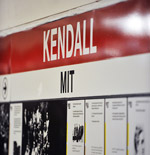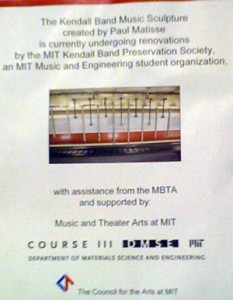Kepler, Pythagoras, and Galileo to Be Revived by MIT
-
-
slice.mit.edu
- 4
Filed Under
Recommended
 Yep, you read it right. But no DNA is involved. I'm talking instead of the three musical instruments that make up the Kendall Band art installation in the Kendall Square T station. They have fallen into disrepair as of late, often not even registering a response when some eager child is hoisted into a parent's arms for the sole purpose of pulling one of the levers that make them sing. You know the joy I'm talking about. So imagine the disappointment at the silence.
Yep, you read it right. But no DNA is involved. I'm talking instead of the three musical instruments that make up the Kendall Band art installation in the Kendall Square T station. They have fallen into disrepair as of late, often not even registering a response when some eager child is hoisted into a parent's arms for the sole purpose of pulling one of the levers that make them sing. You know the joy I'm talking about. So imagine the disappointment at the silence.But thanks to a diligent commuter and some 20 MIT students, the instruments will one day soon resonate. Ringed Kepler will strike its F-sharp. Large swinging mallets will gong Pythagoras's long metal tubes in B-minor. And sheet-metal Galileo will again offer its thunder rumble. The interactive musical sculpture was created by Paul Matisse, grandson of French impressionist Henri Matisse, and installed in 1987.
The work is being conducted by the MIT Kendall Band Preservation Society, an MIT student organization made up of music and engineering students, mostly from the Department of Materials Science and Engineering. According to the Tech, the team hopes to revive the instruments in a few months but then also completely refurbish them, which could take years.
Learn more about the restoration in these articles, including one from a student involved with the project. In the works, according to Wicked Local Cambridge, is an annual competition to write musical pieces for the sculpture which will then be performed on the anniversary of the installation.
—The Tech: Students band together to save Band, includes a photo of the students
—Rapid Fabrication Lab blog: Posts detail the initial work
—Wicked Local Cambridge: MIT students work to repair broken Kendall music sculpture in Cambridge








Comments
Peter L. Griffiths
Thu, 05/12/2011 10:33am
Further to my comment of 16 April 2011, two of Kepler's discoveries are contained in the Introduction to Astronomia Nova (1609), these are that the velocity of the planets is inversely related to their distances from the Sun and that the planetary orbit is elliptical. Greater mathematical precision is given to these discoveries in Kepler's later works also the important concept of the foci.
Peter L. Griffiths
Sat, 04/16/2011 12:51pm
The main motive for Kepler's discoveries was to adjust the recorded observations to take account of Copernicus's discovery that the Earth as the observation point was not stationary but orbited round the Sun.
Jeffrey J. Tre…
Thu, 04/15/2010 3:21am
A problem with the "Kendall Band" is that it prevents any other form of musical performance at Kendall/MIT. No musicians can play in the station so long as they can be instantly drowned out by the metallic clanging of this device, and the steely pounding of endless permutations of F-sharp, B-minor and "thunder" makes for rather monotonous fare. One might hope that, in a public space, MIT would encourage more creativity and freedom of expression than this machine allows. As for Kepler, Pythagoras and Galileo, the names of those who taught us the music of the spheres should grace more varied and lovely notes.
John Evans
Wed, 04/14/2010 5:21pm
Awesome! Those always made my visits to the T more fun.